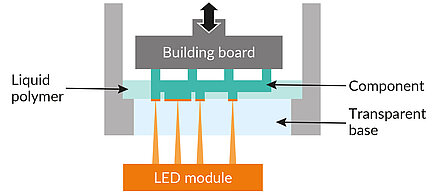Additive manufacturing process: Stereolithography
Stereolithography – like LaserCUSING® | Laser sintering | LaserMelting - an additive manufacturing process that is used in the plastics sector, among other things.
Stereolithography – the process
Basically, stereolithography is a process in which liquid photopolymer is cured in a tank in a targeted manner by light-activated polymerisation.
The component to be manufactured must first be read in by CAM software as a CAD model, usually in STL format. The optimal orientation of the component to the manufacturing platform is then determined in this CAM software. Critical overhangs must be connected to the building board via so-called support structures in order to realize the component in the desired geometry. However, the aim is to use as few support structures as possible in this process, as these have to be removed from the component afterwards. After determining the orientation, the so-called "slicing" takes place. The layer-by-layer information of the component required for the system is generated.
The building board is then lowered into a container with liquid polymer. The LED module illuminates the liquid polymer through the transparent base at the desired points where the component is to be created. By exposing this first layer to light, the resin polymerizes and hardens. The build plate is then raised by the set layer height and the exposure process of the next layer begins. In this way, the component is produced layer by layer and step by step. After the print job has been completed, the finished component can then be manually separated from the building board.
Differences in stereolithographic processes
Originally, in stereolithographic processes, polymerization was carried out using a UV laser. However, this can also be replaced by LEDs or halogen lamps. This technology is known as "Large Area Maskless Photopolymerization" (LAMP) or "Digital Light Projection" (DLP). The exposure can take place both from above and from below. Since the DLP process does not work point by point, but rather cures the entire layer at the same time, components can be manufactured much faster than when exposed to UV lasers.
Advantages of stereolithographic processes
The stereolithographic process is characterized above all by the high level of detail. Commercially available printers achieve a lateral resolution of up to approx. 50 µm, with minimum layer thicknesses of up to approx. 25 µm. In this way, even extremely filigree structures can be manufactured with great precision.
Area of application of stereolithographic processes at CADdent
With the use of stereolithography, the possibilities in the area of CAD/CAM-supported production at CADdent have expanded by many structures. Although model production was already possible in subtractive manufacturing, but was expensive, these structures can now be offered economically for laboratories.
Stereolithography process for resin 3D printing
Stereolithographic production is particularly widespread in the 3D printing of resins. In the dental industry, primarily models, trays and drilling templates are manufactured using this process. However, resin 3D printing is also ideal for the manufacturing of burnable component to produce in a casting mold.
Stereolithography process for ceramics 3D printing
In January 2022, we at CADdent also introduced the ceramic 3D printing process and have since been able to produce ceramic components using an additive manufacturing process.
The so-called LCM process (Lithography-based Ceramic Manufacturing) is used for this. This is closely related to classic stereolithography. Very fine ceramic particles are mixed into the liquid, light-curing polymer. During the subsequent shaping process using light curing, the ceramic particles are enclosed in the cured resin. The component created after shaping – which in this state is referred to as a green body – is thermally freed from the plastic particles in the subsequent “de-binding process”. In order to obtain the final ceramic component, the material is sintered after this process - as you already know from subtractive processes such as milling zirconium - at temperatures of well over 1000°C in some cases. This post-process gives the ceramic component its desired material properties.
CONCLUSION
Thanks to the optimization of the stereolithography process for the dental sector, it is also possible to produce dental models, drilling templates and insertion aids with CAD/CAM support. Stereolithography thus makes a significant contribution to a digital 360° workflow.
An example of such a holistic process is the implant treatment based on backward planning - starting with the digital imaging, through the production of the dentures, to the insertion in the patient's mouth.
Our internal research and development department is constantly working on new processes, innovations, testing new procedures and materials - in order to generate the greatest added value for you and your dental laboratory.
Do you have questions about the use of stereolithographic processes at CADdent? - Our experts will be glad to advise you!
